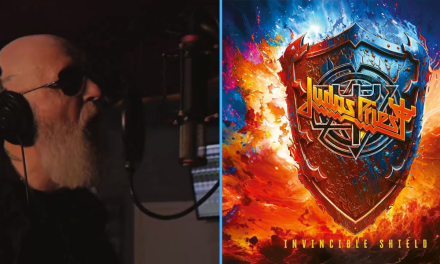If Black Sabbath are the grandfathers of heavy metal, then Judas Priest is the father that outdid them in almost every way. If you ask me to show someone what heavy metal is, I won’t hand them a copy of Paranoid or Master of Reality. I’ll instead hand them a copy of Screaming For Vengeance, British Steel, or Painkiller. That’s what Judas Priest means to the heavy metal community. Without them we wouldn’t have a classic look for heavy metal with studs and leather.
Thin Lizzy and Wishbone Ash might have been the first to use the twin-guitar attack, but Judas Priest was the one that solidified it in the heavy metal sphere. K.K. Downing and Glenn Tipton were and still are probably the best twin guitarists for any band. It was set to be the 50th anniversary celebration for Judas Priest this year. To make up for those shows being postponed, it’s high time for Judas Priest-A-Thon. The brother to the album by album reviews, Iron Maiden-A-Thon and the cousin to our series of Rush album reviews. You’re going to be getting a Judas Priest album review, every business day, until we’re all through.
Defenders Of The Faith might have been a “lesser” album to Screaming For Vengeance but it set up a move to mega-popularity for Judas Priest. They would set records for sales and attendance at the band’s concerts. There was nothing that they couldn’t do muscially at this point. The band took a hiatus in 1985 besides playing one concert at the Live Aid festival for AIDS research. That hiatus would set up for a strange year for the band leading up to the release of their next album, Turbo.
Background on Turbo
The band took that hiatus in different ways. Rob Halford sadly went to rehab during this period after a bout of substance abuse and the suicide of his partner. Halford would come back better after these rehab sessions, with his vocal performances on the Fuel For Life tour given great grades. Judas Priest was hot off the success of their previous two albums going at least Platinum in the US and selling millions around the world.
The musical landscape of the metal world was changing. Studs and leather were getting thrown out, and pop, synth, and more colorful clothing were in. The band started work on their new album in June 1985. That album would originally have a more grand and inventive concept. The original title of this double album was Twin Turbos. This idea went as far as the band recorded enough material for this double album.
They also changed up where they recorded. The band took to the Record Plant in Los Angeles instead of the normal Ibiza Studios. From June of 1985 to February of 1986, they recorded the twenty songs for the Twin Turbos album. Somewhere in development though, the idea for Twin Turbos was scrapped. Instead the most commercially viable songs would be put on a single album, Turbo.
More Background On Turbo
The album was released on April 14th, 1986. It was an immediate commercial success. It went gold in June of 1986 and platinum in July of 1987. The album peaked on the Billboard Charts at number 17 and at number 33 in the UK.
The cover was another done by Doug Johnson, who did the previous two album’s covers. During the Fuel For Life tour that supported the album, the band played seven of the nine tracks. The only one to really survive past and deeper into the Judas Priest catalog was “Turbo Lover”. “Out In The Cold” was brought back for the third leg of the Firepower World Tour in 2019.
During this tour, the band fundamentally changed how they looked and the songs that they played. Songs like “Sinner”, “Tyrant”, and “Exciter” were dropped from the setlist. KK Downing had this to say about why those songs were dropped.
People ask why we don’t play Sinner anymore. I tell them it’s because we’ve all repented.
Priest was changing right before our eyes, but the question remains: Is Turbo a bad album? Let’s find out.
1. Turbo Lover
Iron Maiden and Judas Priest both took to the use of synthesizers in 1986. Iron Maiden with their classic album, Somewhere In Time, brought in the new musical tool in a well-fashioned manner. At least with “Turbo Lover”, Judas Priest does the same thing. If you’ve only listened to the studio track of “Turbo Lover”, you’re in for a whole different experience if you listen or watch it live. The crowd really takes this song from a great song to an instant classic.
There’s a reason why Judas Priest seems to include this song on almost every setlist that they do. The song is a classic and it starts off this album perfectly. I can only imagine what this must have sounded like in 1986.
2. Locked In
Now for something a bit different than any of the other Judas Priest you’ve heard. Complete with more synthesizers than you can shake a stick at, this is as pop (there were three demos we’ll get to when we talk about Ram It Down) as Judas Priest is going to get. It shows the tonal shift in the lyrics for the Turbo album as well. Switching from the heavy and tough lyrical content of their past albums, Judas Priest is now talking about sex, love, and fun more often.
For someone like me, who loves all kinds of 80’s music, including pop, a song like “Locked In” doesn’t turn me off from the music. The song is reasonably heavy, but not like something like “Sinner” or “Bloodstone”. It’s just a fun song that will worm it’s way into your brain.
3. Private Property
This might be the pinnacle on the album of the pop/synthesizer sound though. “Private Property” is another silly sort of mindless song that I’m assuming the private property is private parts. It’s another ear-worm song though, and I’ll keep humming the chorus to this one long after I’ve listened. It’s not too terribly memorable though. “Private Property” does just enough to be fun, but not stick around too long after.
4. Parental Guidance
Judas Priest makes the tongue-in-cheek reference to the PMRC and the trouble they went through with “Eat Me Alive”. It’s not quite “We’re Not Gonna Take It” but what can top that song in primal angst. Lambasting the politicians and tone-deaf parents of the 80’s “Parental Guidance” is another one that sounds silly at first, but it catches up with you. The song is similar sounding to other rah-rah Judas Priest songs of yesteryear. I can imagine this one being a big hit with teens of the time.
Judas Priest comes out front and center and says “we’re smarter than you, we know our music, you don’t”. So metal and rock and roll don’t need any parental guidance. It’s an extension of Judas Priest being the Defenders of the Faith of heavy metal. Also listen for the slight nod to “You’ve Got Another Thing Comin'” at the end of the track.
5. Rock You All Around The World
Now for the weakest song on the album. Unlike the previous two tracks that either had a fun message or just silly lyrics, “Rock You All Around The World” does not. It sounds like it’s going to be a heavy song with the opening riff, but instead it takes the worst of those “stadium chant” songs. Judas Priest were definitely going for a commercial rebellion sound here, and it doesn’t work to me. This is the only song on the album that I skip pretty regularly.
6. Out In The Cold
For the most poppy album that Judas Priest have ever recorded, you’d assume that there would be more than one ballad. “Out In The Cold” combines elements of other songs like “Victim of Changes”, “Sinner”, and other emotional songs. Now I’m not saying it’s up to the quality of those songs, but this is one that Judas Priest played on their most recent tour. There it was fantastic. If you’ve watched the live show Priest…Live! this is what opens the show. The band comes out at varying points in the opening and finally Rob Halford struts on stage singing. It’s fantastic. No matter what one might think of this era of the band, this song is great.
“Out In The Cold” talks about a lost love or a relationship that’s on the rocks. You’re left out in the cold every night hoping that person comes back to warm you and the relationship up. Except this time, you’re the one that messed things up.
“Out In The Cold” doesn’t reinvent the Judas Priest wheel, but it definitely sticks out on this album as a major track. Give it a listen.
7. Wild Nights, Hot & Crazy Days
This is my pick for “Most Fun and Makes You Want To Party” song on the album. “Wild Nights, Hot & Crazy Days” might not be the most eloquent title or song on the album, but it captures that feeling of being young during the summer. You’re up all day waiting for the moon to come out. There’s some magical quality about the whole package of the song. The other tracks on Turbo that share lyrical content to this one don’t have the feelings and emotions that this song evokes. It’s one of my most favorite tracks from Judas Priest.
8. Hot For Love
This is probably the heaviest song on the record. It doesn’t sound like that early on, but once you get past the synths, the riffs kick up. “Hot For Love” is another of the sort of generic sounding love, sex, lust songs from Judas Priest on this record. The chorus is pretty catchy, and generally, like everywhere else on this record, the musicianship is top notch. It just doesn’t really stand out among some of the other tracks.
9. Reckless
If “Wild Nights, Hot & Crazy Days” was my pick for Most Fun Song on the Album, then “Reckless” is my pick for Most Underrated Track on the Album. It’s a favorite track of Richie Faulkner and I’m assuming that it’ll be apart of a Judas Priest setlist near you. It just happens to be one of the two songs that they’ve never played live from this record. I included it on my Judas Priest Dream Setlist article from awhile ago. I love this song that much.
Funnily enough, Judas Priest was asked to put this song on the soundtrack for Top Gun. They didn’t want to take it off the album. More foolish, they thought the film would flop. It led to Judas Priest recording “Johnny B. Goode” for a film flop. I could totally picture “Reckless” in Top Gun though. It’s a great song, that’s tucked away at the back half of Turbo.
Score, Personal Thoughts On Turbo, and Why You’re Wrong To Think It Sucks

Turbo is considered among many circles to be the most maligned of the Judas Priest catalog before Rob Halford left the band. The album stripped away some of the elements that 70s and early 80s Priest fans loved about the band. I’m a firm believer in finding the good in releases before passing judgement. If I enjoy listening to something, I don’t really care about if it radically changes the sound of the band.
If you read my reviews of Iron Maiden’s The X-Factor and Virtual XI, those albums are among my favorite Maiden albums. There’s something good in most albums that your favorite bands release, why would they be your favorites if they didn’t? The argument against Turbo is that the synthesizers and lyrics take away from the heavy metal thunder of Judas Priest. I’ll concede that point that it’s a radical departure. But let’s take a trip back to 1985-86.
Everyone in metal besides only the most thrashing, hardcore bands were glam’ing it up. Ozzy Osbourne went to the hairdresser. So Judas Priest was setting the trend with this album. If you hate synthesizers, then you have to hate Somewhere In Time. I know that’s not fair to people, but those people need to be more fair to this album.
Turbo Is The Most Underrated Judas Priest Album
Turbo combines two of my favorite musical loves: heavy metal and 80s pop music. Those two genres can lend themselves to having some of the happiest and most fun music around. That’s exactly the reason why Turbo is so fun. Imagine yourself being a Judas Priest fan or just a fan of heavy metal in general in the 80s. The music on the album lends itself to a lighter, more party-like atmosphere. It calls back to an era where you could just hang out and blast some music to have a good time. I know that might make this 25 year old sound like a geezer, but it’s the truth.
This album isn’t perfect, but to be completely honest, how much of a run was Judas Priest on (besides the speed bump of Point of Entry)? Sad Wings Of Destiny to Defenders of the Faith is one of the best runs any band has ever gone on. The sound for Judas Priest evolved over that time, this is just another evolution for it. For this reason, I’m giving Turbo a 9/10. The album is just fun and even though some of the songs might be generic and cheesy, they sound good to me.
Turbo was an album that I found after being a Judas Priest fan for awhile. I listened to other people’s opinions about the album who said it sucked, and I avoided it. Yes, I knew about “Turbo Lover” but thanks to the Priest…Live! show, I found out more about this album. I finally sat down and listened to the whole thing, and realized how wrong I might have been about this one. If you’re looking for a fun time and 40 minutes to brighten up your day, check out Turbo.
Aftermath Of Turbo
Judas Priest would hit the road for Turbo on the Fuel For Life Tour. That tour would see somewhat diminished audiences for the band, but overall it was a successful tour and album. After this they would head back into the studio to record the follow-up to Turbo. This next album was a bridge between two eras of Judas Priest and another underrated gem in their catalog, Ram It Down. You’ll have to check back tomorrow for that one though.
For more on Judas Priest, heavy metal, or any other general pop culture, make sure to check back to That Hashtag Show.
All images and audio are courtesy of Judas Priest.





